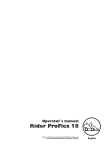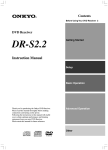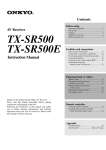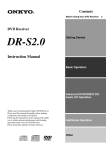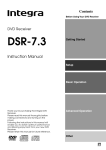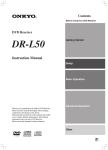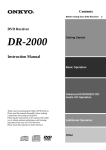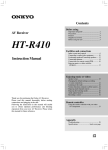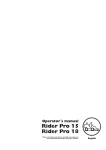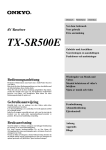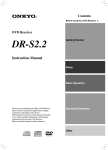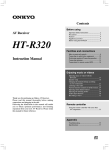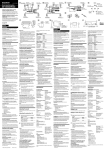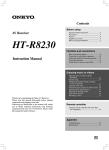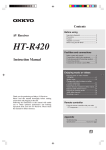Download Onkyo TX-L5 5.1 Channels Receiver
Transcript
Contents Before Using Your AV Receiver 2 AV Receiver TX-L5 Instruction Manual Getting started Turning on the AV Receiver/ Speaker Setup Enjoying music or videos Enjoying Surround mode/ Recording Thank you for purchasing the Onkyo AV Receiver. Please read this manual thoroughly before making connections and turning on the power. Following the instructions in this manual will enable you to obtain optimum performance and listening enjoyment from your new AV Receiver. Please retain this manual for future reference. Other SN 29343138 TX-L5.E WARNING: TO REDUCE THE RISK OF FIRE OR ELECTRIC SHOCK, DO NOT EXPOSE THIS APPLIANCE TO RAIN OR MOISTURE. CAUTION: WARNING RISK OF ELECTRIC SHOCK DO NOT OPEN AVIS RISQUE DE CHOC ELECTRIQUE NE PAS OUVRIR TO REDUCE THE RISK OF ELECTRIC SHOCK, DO NOT REMOVE COVER (OR BACK). NO USER-SERVICEABLE PARTS INSIDE. REFER SERVICING TO QUALIFIED SERVICE PERSONNEL. The lightning flash with arrowhead symbol, within an equilateral triangle, is intended to alert the user to the presence of uninsulated “dangerous voltage” within the product’s enclosure that may be of sufficient magnitude to constitute a risk of electric shock to persons. The exclamation point within an equilateral triangle is intended to alert the user to the presence of important operating and maintenance (servicing) instructions in the literature accompanying the appliance. Important Safeguards 1. Read Instructions – All the safety and operating instructions should be read before the appliance is operated. 2. Retain Instructions – The safety and operating instructions should be retained for future reference. 3. Heed Warnings – All warnings on the appliance and in the operating instructions should be adhered to. 4. Follow Instructions – All operating and use instructions should be followed. 5. Cleaning – Unplug the appliance from the wall outlet before cleaning. The appliance should be cleaned only as recommended by the manufacturer. 6. Attachments – Do not use attachments not recommended by the appliance manufacturer as they may cause hazards. 7. Water and Moisture – Do not use the appliance near water –for example, near a bath tub, wash bowl, kitchen sink, or laundry tub; in a wet basement; or near a swimming pool; and the like. 8. Accessories – Do not place the appliance on an unstable cart, stand, tripod, bracket, or table. The appliance may fall, causing serious injury to a child or adult, and serious damage to the appliance. Use only with a cart, stand, tripod, bracket, or table recommended by the manufacturer, or sold with the appliance. Any mounting of the appliance should follow the manufacturer’s instructions, and should use a mounting accessory recommended by the manufacturer. 9. An appliance and cart combination PORTABLE CART WARNING should be moved with care. Quick stops, excessive force, and uneven surfaces may cause the appliance and cart combination to overturn. 10.Ventilation – Slots and openings in S3125A the cabinet are provided for ventilation and to ensure reliable operation of the appliance and to protect it from overheating, and these openings must not be blocked or covered. The openings should never be blocked by placing the appliance on a bed, sofa, rug, or other similar surface. The appliance should not be placed in a built-in installation such as a bookcase or rack unless proper ventilation is provided. There should be free space of at least 20 cm (8 in.) and an opening behind the appliance. 11.Power Sources – The appliance should be operated only from the type of power source indicated on the marking label. If you are not sure of the type of power supply to your home, consult your appliance dealer or local power company. 12.Grounding or Polarization – The appliance may be equipped with a polarized alternating current line plug (a plug having one blade wider than the other). This plug will fit into the power outlet only one way. This is a safety feature. If you are unable to insert the plug fully into the outlet, try reversing the plug. If the plug should still fail to fit, contact your electrician to replace your obsolete outlet. Do not defeat the safety purpose of the polarized plug. 13.Power-Cord Protection – Power-supply cords should be routed so that they are not likely to be walked on or pinched by items placed upon or against them, paying particular attention to cords at plugs, convenience receptacles, and the point where they exit from the appliance. 2 SN 29343138 TX-L5.E 14.Outdoor Antenna Grounding – If an outside antenna or cable system is connected to the appliance, be sure the antenna or cable system is grounded so as to provide some protection against voltage surges and built-up static charges. Article 810 of the National Electrical Code, ANSI/NFPA 70, provides information with regard to proper grounding of the mast and supporting structure, grounding of the lead-in wire to an antenna-discharge unit, size of grounding conductors, location of antenna-discharge unit, connection to grounding electrodes, and requirements for the grounding electrode. See Figure 1. 15.Lightning – For added protection for the appliance during a lightning storm, or when it is left unattended and unused for long periods of time, unplug it from the wall outlet and disconnect the antenna or cable system. This will prevent damage to the appliance due to lightning and power-line surges. 16.Power Lines – An outside antenna system should not be located in the vicinity of overhead power lines or other electric light or power circuits, or where it can fall into such power lines or circuits. When installing an outside antenna system, extreme care should be taken to keep from touching such power lines or circuits as contact with them might be fatal. 17.Overloading – Do not overload wall outlets, extension cords, or integral convenience receptacles as this can result in a risk of fire or electric shock. 18.Object and Liquid Entry – Never push objects of any kind into the appliance through openings as they may touch dangerous voltage points or short-out parts that could result in a fire or electric shock. Never spill liquid of any kind on the appliance. 19.Servicing – Do not attempt to service the appliance yourself as opening or removing covers may expose you to dangerous voltage or other hazards. Refer all servicing to qualified service personnel. 20.Damage Requiring Service – Unplug the appliance form the wall outlet and refer servicing to qualified service personnel under the following conditions: A. When the power-supply cord or plug is damaged, B. If liquid has been spilled, or objects have fallen into the appliance, C. If the appliance has been exposed to rain or water, D. If the appliance does not operate normally by following the operating instructions. Adjust only those controls that are covered by the operating instructions as an improper adjustment of other controls may result in damage and will often require extensive work by a qualified technician to restore the appliance to its normal operation, E. If the appliance has been dropped or damaged in any way, and F. When the appliance exhibits a distinct change in performance – this indicates a need for service. 21.Replacement Parts – When replacement parts are required, be sure the service technician has used replacement parts specified by the manufacturer or have the same characteristics as the original part. Unauthorized substitutions may result in fire, electric shock, or other hazards. 22.Safety Check – Upon completion of any service or repairs to the appliance, ask the service technician to perform safety checks to determine that the appliance is in proper operation condition. 23.Wall or Ceiling Mounting – The appliance should be mounted to a wall or ceiling only as recommended by the manufacturer. 24.Heat – The appliance should be situated away from heat sources such as radiators, heat registers, stoves, or other appliances (including amplifiers) that produce heat. FIGURE 1: EXAMPLE OF ANTENNA GROUNDING AS PER NATIONAL ELECTRICAL CODE, ANSI/NFPA 70 ANTENNA LEAD IN WIRE GROUND CLAMP ANTENNA DISCHARGE UNIT (NEC SECTION 810-20) ELECTRIC SERVICE EQUIPMENT GROUNDING CONDUCTORS (NEC SECTION 810-21) GROUND CLAMPS NEC – NATIONAL ELECTRICAL CODE S2898A POWER SERVICE GROUNDING ELECTRODE SYSTEM (NEC ART 250, PART H) Precautions ■ For British models ■ For U.S. models Replacement and mounting of an AC plug on the power supply cord of this unit should be performed only by qualified service personnel. IMPORTANT The wires in the mains lead are coloured in accordance with the following code: Blue : Neutral Brown : Live As the colours of the wires in the mains lead of this apparatus may not correspond with the coloured markings identifying the terminals in your plug, proceed as follows: The wire which is coloured blue must be connected to the terminal which is marked with the letter N or coloured black. The wire which is coloured brown must be connected to the terminal which is marked with the letter L or coloured red. IMPORTANT A 5 ampere fuse is fitted in this plug. Should the fuse need to be replaced, please ensure that the replacement fuse has a rating of 5 amperes and that it is approved by ASTA or BSI to BS1362. Check for the ASTA mark or the BSI mark on the body of the fuse. IF THE FITTED MOULDED PLUG IS UNSUITABLE FOR THE SOCKET OUTLET IN YOUR HOME THEN THE FUSE SHOULD BE REMOVED AND THE PLUG CUT OFF AND DISPOSED OF SAFELY. THERE IS A DANGER OF SEVERE ELECTRICAL SHOCK IF THE CUT OFF PLUG IS INSERTED INTO ANY 13 AMPERE SOCKET. If in any doubt, consult a qualified electrician. Declaration of Conformity We, ONKYO EUROPE ELECTRONICS GmbH INDUSTRIESTRASSE 20 82110 GERMERING, GERMANY declare in own responsibility, that the ONKYO product described in this instruction manual is in compliance with the corresponding technical standards such as EN60065, EN55013, EN55020 and EN61000-3-2, -3-3. GERMERING, GERMANY I. MORI ONKYO EUROPE ELECTRONICS GmbH Note to CATV system installer: This reminder is provided to call the CATV system installer's attention to Section 820-40 of the NEC which provides guidelines for proper grounding and, in particular, specifies that the cable ground shall be connected to the grounding system of the building, as close to the point of cable entry as practical. FCC Information for User CAUTION: The user changes or modifications not expressly approved by the party responsible for compliance could void the user’s authority to operate the equipment. NOTE: This equipment has been tested and found to comply with the limits for a Class B digital device, pursuant to Part 15 of the FCC Rules. These limits are designed to provide reasonable protection against harmful interference in a residential installation. This equipment generates, uses and can radiate radio frequency energy and, if not installed and used in accordance with the instructions, may cause harmful interference to radio communications. However, there is no guarantee that interference will not occur in a particular installation. If this equipment does cause harmful interference to radio or television reception, which can be determined by turning the equipment off and on, the user is encouraged to try to correct the interference by one or more of the following measures: • Reorient or relocate the receiving antenna. • Increase the separation between the equipment and receiver. • Connect the equipment into an outlet on a circuit different from that to which the receiver is connected. • Consult the dealer or an experienced radio/TV technician for help. ■ For Canadian models NOTE: THIS CLASS B DIGITAL APPARATUS COMPLIES WITH CANADIAN ICES-003. For models having a power cord with a polarized plug: CAUTION: TO PREVENT ELECTRIC SHOCK, MATCH WIDE BLADE OF PLUG TO WIDE SLOT, FULLY INSERT. ■ Modele pour les Canadien REMARQUE: CET APPAREIL NUMÉRIQUE DE LA CLASSE B EST CON-FORME À LA NORME NMB-003 DU CANADA. Sur les modèles dont la fiche est polarisée: ATTENTION: POUR ÉVITER LES CHOCS ÉLECTRIQUES, INTRODUIRE LA LAME LA PLUS LARGE DE LA FICHE DANS LA BORNE CORRESPONDANTE DE LA PRISE ET POUSSER JUSQU’AU FOND. 3 SN 29343138 TX-L5.E Precautions Features 1. Recording Copyright Amplifier Features Recording of copyrighted material for other than personal use is illegal without permission of the copyright holder. ■ Rated output power (6 ohms, 1 kHz, 0.6% THD): Front 22 W + 22 W, center 22 W, surround 22 W + 22 W ■ 24-bit DSP chip featuring high-speed processing and excellent reliability ■ Stabilized ground potential, which is the basis of audio signal amplitudes ■ Dolby* Digital & Dolby Pro Logic II decoder and DTS** decoder ■ Acoustic Control function ■ Subwoofer pre-output ■ Five sets of audio input connectors and three sets of audio output connectors ■ S-Video input/output ■ Heat-resistance, slim power transformer ■ Large extruded-aluminum heat sinks ■ Three digital input connectors ■ Onkyo-original surround modes with five sophisticated modes (Orchestra, Unplugged, Studio Mix, TV Logic and All Channel Stereo) for natural audio reproduction ■ Late Night function 2. AC Fuse The fuse is located inside the chassis and is not user-serviceable. If power does not come on, contact your Onkyo authorized service station. 3. Care From time to time you should wipe the front and rear panels and the cabinet with a soft cloth. For heavier dirt, dampen a soft cloth in a weak solution of mild detergent and water, wring it out dry, and wipe off the dirt. Following this, dry immediately with a clean cloth. Do not use rough material, thinners, alcohol or other chemical solvents or cloths since these could damage the finish or remove the panel lettering. 4. Power WARNING BEFORE PLUGGING IN THE UNIT FOR THE FIRST TIME, READ THE FOLLOWING SECTION CAREFULLY. The voltage of the available power supply differs according to country or region. Be sure that the power supply voltage of the area where this unit will be used meets the required voltage (e.g., AC 230 V, 50 Hz or AC 120 V, 60 Hz) written on the rear panel. Worldwide models are equipped with a voltage selector to conform to local power supplies. Be sure to set this switch to match the voltage of the power supply in your area before plugging in the unit. FM/AM Tuner Features ■ ■ ■ ■ 30 FM/AM random presets FM auto tuning FM indoor antenna supplied AM indoor antenna supplied * Manufactured under license from Dolby Laboratories. “Dolby”, “Pro Logic” and the double-D symbol are trademarks of Dolby Laboratories. Confidential Unpublished Works. ©19921997 Dolby Laboratories. All rights reserved. **Manufactured under license from Digital Theater Systems, Inc. US Pat. No.5,451,942 and other worldwide patents issues and pending, “DTS” and “DTS Digital Surround” are trademarks of Digital Theater Systems, Inc. ©1996 Digital Theater Systems, Inc. All Rights reserved. Memory Preservation This unit does not require memory preservation batteries. A built-in memory power backup system preserves the contents of memory during power failures and even when the POWER switch is set to OFF. The POWER switch must be set to ON in order to charge the backups system. The memory preservation period after the unit has been turned off varies depending on climate and placement of the unit. On average, memory contents are protected over a period of a few weeks after the time the unit has been turned off. This period is shorter when the unit is exposed to a very humid climate. 4 SN 29343138 TX-L5.E Table of Contents Important Safeguards/Precautions/Features/Table of Contents ....................... 2–5 Getting Started Supplied Accessories ............................................................................................ 6 Preparing the Remote Controller .......................................................................... 7 Index to Parts and Controls .................................................................................. 8 Connecting to Audio/Video Equipment ................................................................ 12 Positioning Speakers .......................................................................................... 14 Connecting Speakers .......................................................................................... 15 Making Antenna (Aerial) Connections ................................................................. 16 Connection for remote control (z) .................................................................... 18 Turning on the AV Receiver/Speaker Setup Connecting the Power/Turning on the AV Receiver ............................................ 19 Speaker Setup .................................................................................................... 20 Enjoying music or videos Listening to the Radio ......................................................................................... 23 Playing the Connected Source ........................................................................... 26 Various Functions Common to all the Sources ................................................... 28 Enjoying Surround mode/Recording Enjoying the Surround Modes ............................................................................. 30 Recording a source ............................................................................................. 35 Other Troubleshooting .................................................................................................. 36 Specifications ...................................................................................................... 38 Memo .................................................................................................................. 39 5 SN 29343138 TX-L5.E Supplied Accessories Make sure your box contains everything listed below. If any pieces are missing, contact your nearest Onkyo dealer. The number of accessories is indicated in brackets. Remote controller (RC-453S) [1] Batteries (size AA/R6/UM3) [2] FM antenna (aerial) [1] (USA and Canadian models) AM loop antenna (aerial) [1] FM outdoor antenna (aerial) adapter [1] (Supplied only for Asian and Austrarian models) 6 SN 29343138 TX-L5.E (Other models) Preparing the Remote Controller Inserting the Batteries Using the Remote Controller Point the remote controller toward the remote control sensor. 1 Detach the battery cover. Remote control sensor et ) 30˚ 5m (1 6 fe 30˚ 2 Insert the two size AA/R6/UM3 batteries. Be sure to match the + and – ends of the batteries with the diagram inside the battery compartment. Notes ª · ª 3 Attach the battery cover. • Place the unit away from strong light such as direct sunlight or inverted fluorescent light which can prevent proper operation of the remote controller. • Using another remote controller of the same type in the same room or using the unit near equipment which uses infrared rays may cause operational interference. • Do not put any object (such as a book) on the remote controller. The buttons of the remote controller may be pressed by mistake and drain the batteries. • Make sure the audio rack doors do not have colored glass. Placing the unit behind such doors may prevent proper remote controller operation. • If there is any obstacle between the remote controller and the remote control sensor, the remote controller will not operate. Notes • Do not mix new batteries with old batteries or different kinds of batteries. • To avoid corrosion, remove the batteries if the remote controller is not to be used for a long time. • Remove dead batteries immediately to avoid damage from corrosion. If the remote controller does not operate smoothly, replace both batteries at the same time. • The life of the supplied batteries is about six months but this varies depending on usage. 7 SN 29343138 TX-L5.E Index to Parts and Controls For operational instructions, refer to the page indicated in brackets. ■ Front panel 12 3 4 5 6 7 VOLUME STANDBY / ON INPUT ON DVD / C D VIDEO 1 VIDEO 2 HD MD / TAPE FM AM STANDBY POWER ON PHONES SURROUND STEREO SUBWOOFER MODE MEMORY FM MODE TUNING/PRESET ACOUSTIC CONTROL OFF AV RECEIVER 8 9 0 - = ~ ! TX-L5 @ 1 POWER switch [19] 8 PHONES jack [29] Turns on the main power supply for the TX-L5. The TX-L5 enters standby state and the STANDBY indicator lights up. Pressing the switch again to the off position (— OFF) shuts down the main power supply into the TX-L5. • Before turning on the power, make sure all cables are properly connected. • Turning on the TX-L5 may cause a momentary power surge that might interfere with other electrical equipment on the same circuit. If this is a problem, plug the TX-L5 into a different electrical circuit. This is a standard stereo jack for connecting stereo headphones. The audio for the front right and left speakers are sent to the headphone speakers. When the headphones are plugged in, the listening mode automatically changes to STEREO and sounds are not output from the speakers. 2 STANDBY/ON button, ON indicator, STANDBY indicator [19] When STANDBY/ON button is pressed to ON while the POWER switch is set to ON, the display will light to show the current volume setting for about 5 seconds then show the current sound input source and listening mode. Pressing the button again returns the TX-L5 to the standby state. This state turns off the display, disables control functions. 9 SURROUND button [32] Press this button to select a surround mode for current input source. 0 STEREO button [32] Press this button to change the sound to stereo. - SUBWOOFER MODE button [20] Press to select the subwoofer mode. = MEMORY button [24, 25] This button is used to assign the radio station that is currently tuned in to a preset channel or delete a previously preset station. 3 Source indicators [23, 26] ~ FM MODE button [23, 25] One of these indicators lights to show the current source. This sensor receives the control signals from the remote controller. Press to switch the reception mode between stereo and monaural. If audio is interrupted or noise interferes with audio during FM stereo broadcasting, press this button to switch to the monaural reception mode. 5 Display [9] ! TUNING/PRESET ™/£ button [23, 24] 4 Remote control sensor [7] 6 INPUT dial [23, 26, 35] The INPUT dial is used to select the input source. 7 VOLUME dial [23, 26] The VOLUME dial is used to control the volume level. Turn the dial clockwise to increase the volume level and counterclockwise to decrease it. 8 SN 29343138 TX-L5.E Use these buttons to change the tuner frequency. The tuner frequency is displayed in the front display and it can be changed in 50 kHz increments for FM and 10 kHz (or 9 kHz) increments for AM. Also, These buttons make it possible to store desired radio stations under the desired preset numbers and recall them with an easy operation. @ ACOUSTIC CONTROL button/indicator [34] Press to change the acoustic mode to enjoy more dynamic sounds by boosting the super bass/high frequency sounds. For operational instructions, refer to the page indicated in brackets. ■ Display 1 2 3 4 5 6 7 8 RDS 9 1 SLEEP indicator [29] 6 FM MUTE indicator [23] Lights up when the sleep timer is active. Lights up to indicate FM muting. It extinguishes when the monaural reception mode is started by pressing the FM MODE button. 2 Source/Listening mode indicators [26, 32] One of these indicators lights to show the format of the current source as “PCM DIGITAL”, “Ÿ DIGITAL” or “DTS”. In addition, one of the listening mode indicators “Ÿ PRO LOGIC II”, “DSP” and “STEREO” lights according to the current listening mode. 3 MUTING indicator [29] 7 RDS indicator (European models only) [23] Lights up when a RDS station is received. 8 MEMORY indicator [24] Lights up when the MEMORY button is pressed in the radio station preset operation. Flashes when the mute function is active. 9 Multi function display 4 FM STEREO indicator [23] Lights up when an FM stereo broadcast station is received. 5 TUNED indicator [23] Lights up when a radio station is received. In usual operation, shows the current input source and volume. When the FM or AM input is selected, it shows the frequency and preset number. When the DISPLAY button is pressed, it shows the listening mode and input source format. However, it does not show the source format when the input source signal is analog, or when the FM or AM source is selected. 9 SN 29343138 TX-L5.E Index to Parts and Controls For operational instructions, refer to the page indicated in brackets. ■ Rear panel 1 DVD/CD IN 2 VIDEO 2 VIDEO 1 OUT IN IN MON OUT 3 DVD/CD IN 4 5 VIDEO 2 MON OUT VIDEO 1 OUT IN IN REMOTE CONTROL VIDEO 6 DIGITAL INPUT SUB WOOFER 7 SURROUND SPEAKERS L R 8 CENTER SPEAKER FRONT SPEAKERS R L DVD (OPTICAL) S VIDEO IN OUT IN IN IN OUT OUT PRE OUT VIDEO 2 (COAXIAL) IN L ANTENNA L HD (OPTICAL) AV RECEIVER MODEL NO. TX-L5 AUDIO R R FM 75 AM DVD/CD VIDEO 1 VIDEO 2 HD 9 MD/TAPE 0 1 VIDEO (DVD/CD IN / VIDEO 1 OUT/IN / VIDEO 2 IN) [13] 5 SUB WOOFER PRE OUT [15] There are 3 video inputs and 1 output. Connect DVD players, LD players, VCRs or other video components to the video inputs. The video output channel can be used to be connected to video tape recorder for making recordings. This terminal is for connecting an active subwoofer. 2 MON OUT [12] The monitor output includes both RCA type and S video configurations. This output is for connecting television monitors or projectors. 3 S VIDEO (DVD/CD IN / VIDEO 1 OUT/IN / VIDEO 2 IN) [13] There are 3 video inputs and 1 output. Connect DVD players, LD players, VCRs or other video components to the video inputs. The video output channel can be used to be connected to video tape recorder for making recordings. 4 z (REMOTE CONTROL) [18] Connect the Onkyo components that have z connectors such as a CD player, and cassette tape deck using the z cables provided with them. When these components are interconnected, they can be controlled from the remote controller provided with the TX-L5. After connecting the z connectors, check the operation of the remote controller buttons for use in controlling other components (refer to page 27). • The z connectors are only effective if they are used in conjunction with an Onkyo amplifier with an z connector. Do not connect to a component other than Onkyo component with an z connector. Doing so may damage the TX-L5. • Connecting z cable only does not make the system operational. You must also connect the audio cables as well. • If the connected component has two z connectors, you can use either one to connect to the TX-L5. The other one can be used to daisy chain with another component. 10 SN 29343138 TX-L5.E 6 DIGITAL INPUT (DVD, HD (OPTICAL), VIDEO 2 (COAXIAL)) [12, 13] These are the digital audio inputs. There are 2 digital inputs with optical jacks and 1 with a coaxial jack. The inputs accept digital audio signals from DVD players, hard disk recorders, CD players, or other digital source component. 7 SURROUND SPEAKERS L/R, CENTER SPEAKER [15] Speaker terminals are provided for the center, surround left and surround right speakers. 8 FRONT SPEAKERS L/R [15] Speaker terminals are provided for the front left, front right speakers. Speaker outputs are compatible with banana plug connectors (other than European models). 9 AUDIO L/R (DVD/CD IN / VIDEO 1 OUT/IN / VIDEO 2 IN / HD OUT/IN / MD/TAPE OUT/IN) [12, 13] These are the analog audio inputs and outputs. There are 5 audio inputs and 3 audio outputs. The audio inputs and outputs require RCA type connectors. When connecting a VCR or other video component, make sure you connect the audio and video leads together (i.e., both to VIDEO 1). 0 ANTENNA [16, 17] These terminals are for connecting the FM antenna and AM antenna. For operational instructions, refer to the page indicated in brackets. ■ Remote Controller For detailed descriptions on the buttons, see “Front panel facilities” on pages 8. 1 9 ON STANDBY SLEEP DIMMER 2 0 Put the TX-L5 in standby. - 2 ON button [19] = 3 INPUT SELECTOR buttons [26, 27, 35] DVD/CD VIDEO 1 VIDEO 2 DISPLAY 3 INPUT SELECTOR HD MD/TAPE TUNER DVD MD Control DVD MD 1 STANDBY button [19] ESET PR Turns on the TX-L5. For selecting the input source. TOP MENU MENU 4 DVD•MD Control buttons [27] For operating z-connected Onkyo components connected to the TX-L5. ENTER 4 RETURN SETUP 5 SURR MODE button [32] Press to select the surround mode. PLAY 6 STEREO button [32] Press to change the listening mode to stereo. 5 6 7 SURR MODE STEREO SP SETUP SW MODE 7 SP SETUP/SW MODE/TEST TONE/CH SEL/DISTANCE/ 5/∞ buttons [20-22, 33] TEST TONE CH SEL DISTANCE LATE NIGHT A.CTRL 8 MUTING VOLUME REMOTE CONTROLLER RC-453S ~ ! @ For setting the output levels for each speaker. These buttons are provided only on the remote controller. 8 LATE NIGHT button [34] Press to change the late night setting. This button is provided only on the remote controller. 9 SLEEP button [29] For setting the sleep timer. This button is provided only on the remote controller. 0 DIMMER button [28] For adjusting the brightness of the front display. This button is provided only on the remote controller. - DISPLAY button [28] For changing the display. = PRESET 5/∞ button [24] For selecting a tuner preset channel. ~ MUTING button [29] Activates the mute function. This button is provided only on the remote controller. ! A.CTRL button [34] Press to change the acoustic mode to boost the super bass/high frequency sounds. @ VOLUME 5/∞ button [26] For adjusting the volume. 11 SN 29343138 TX-L5.E Connecting to Audio/Video Equipment Before connecting Incomplete • Connect the plugs securely. • Refer also to the instruction manual of each component to be connected. • When you connect the AV Receiver to audio/video equipment, be sure to turn off the power and unplug all the units from the mains before making any connections. • About the DVD, VIDEO 1 and VIDEO 2 jacks The video input/output connections are also necessary even if you make the S video input/output connections. • About DIGITAL INPUT (OPTICAL) jack Remove the protective caps before making connections. When not in use, be sure to replace them. Insert completely Example of monitor and audio equipment connections VIDEO Video connection cable (Analog signal) TV monitor or Projector (MON OUT) S video plug S video connection cable (S video signal) Audio (L) VIDEO S VIDEO IN IN Audio connection cable (Analog signal) Audio (R) Optical plug Note Optical cable (Digital signal) The signal that comes in from S VIDEO IN is sent to S VIDEO OUT. The signal that comes in from VIDEO IN is sent to VIDEO OUT. Signal flow IN VIDEO 2 VIDEO 1 DVD/CD OUT IN IN MON OUT DVD/CD IN VIDEO 2 MON OUT VIDEO 1 OUT IN IN REMOTE CONTROL VIDEO DIGITAL INPUT SUB WOOFER SURROUND SPEAKERS L R CENTER SPEAKER FRONT SPEAKERS R L DVD (OPTICAL) S VIDEO IN OUT IN IN IN OUT OUT PRE OUT VIDEO 2 (COAXIAL) IN L HD (OPTICAL) ANTENNA L AV RECEIVER DOTX-L5 NOT connect the power cord (mailns lead) at this time. AUDIO R R AM DVD/CD DIGITAL OUT OPTICAL VIDEO 1 VIDEO 2 R L AUDIO IN (REC) HD R L AUDIO OUT (PLAY) Digital audio processor, Hard disk recorder etc. (HD) 12 SN 29343138 TX-L5.E FM 75 MD/TAPE R L AUDIO IN (REC) R L AUDIO OUT (PLAY) Cassette Tape deck, MD recorder, DAT deck, CD recorder (MD/TAPE) Example of video equipment connections DVD player, CD player or LD player* (DVD/CD) AUDIO OUT R VIDEO S VIDEO OUT OUT L Satellite tuner etc. (VIDEO 2) DIGITAL OUT AUDIO OUT R OPTICAL VIDEO S VIDEO DIGITAL OUT OUT OUT L COAXIAL * If you have an LD player with AC-3RF output, connect via an AC-3RF demodulator to one of the TX-L5’s DIGITAL INPUT terminals. VIDEO 2 VIDEO 1 DVD/CD OUT IN IN IN MON OUT DVD/CD IN VIDEO 2 MON OUT VIDEO 1 OUT IN IN REMOTE CONTROL VIDEO DIGITAL INPUT SUB WOOFER SURROUND SPEAKERS L R CENTER SPEAKER FRONT SPEAKERS R L DVD (OPTICAL) S VIDEO IN OUT IN IN IN OUT OUT VIDEO 2 (COAXIAL) PRE OUT IN L HD (OPTICAL) ANTENNA L AV RECEIVER DOTX-L5 NOT connect the power cord (mailns lead) at this time. AUDIO R R AM DVD/CD VIDEO 1 HD VIDEO 2 FM 75 MD/TAPE Video Audio (L) Audio/video connection cable Audio (R) S video plug S video cable (S video signal) Coaxial plug Coaxial cable (Digital signal) Optical plug Optical cable (Digital signal) R L AUDIO IN R VIDEO IN Signal flow L AUDIO OUT VIDEO S VIDEO S VIDEO OUT IN OUT VCR (VIDEO 1) 13 SN 29343138 TX-L5.E Positioning Speakers The front left, center, and right speakers, surround left and right speakers, and subwoofer can be connected to the AV receiver. You can reproduce the sounds such as Dolby surround and DTS surround. ■ Standard speaker placement Speaker placement plays an important role in the reproduction of Surround sound. The placement of the speakers varies depending on the size of the room and the wall coverings used in the room. The illustration below shows an example of a layout for standard speaker placement. Refer to this example when you position the speakers in order to experience the best of Surround sound. For ideal Surround effects, all speakers should be installed. If a center speaker or subwoofer is not connected, the sound from the unused channel is properly distributed to the connected speakers in order to reproduce the best Surround sound possible. Front The center speaker reproduces a richer sound image by enhancing the perception of the sound's source and movement. The left, right, and center speakers should face the seated listener and be placed at ear level. Surround The surround speakers reproduce the feel of a moving sound while creating the sensation of being in the middle of the action. Place the left and right surround speakers 1 meter (3 feet) above the listener's ear level and facing toward the sides of the room, making sure that the listener is within the speakers' dispersion angle. Subwoofer Install a subwoofer with a built-in power amplifier for powerful bass sounds. The placement of the subwoofer does not affect the final quality of the sound image much, therefore, you can install it wherever it is convenient. Refer to the speakers’ instruction manuals for details. TV/Screen t Front lef er ak Spe Surround left Speaker 14 SN 29343138 TX-L5.E Subwoofer Front Center Speaker Fron t ri Speght ake r Surround right Speaker Connecting Speakers Before connecting • Do not connect more than one speaker cable to one speakerterminal. Doing so may damage the TX-L5. • When you are using only one speaker or when you wish to listen to monaural (mono) sound, a single speaker should never be connected in parallel to both the right and left channel terminals simultaneously. • Refer also to the instruction manuals of the speakers. • Be sure to connect the positive and negative cables for the speakers properly. If they are mixed up, the left and right signals will be reversed and the audio will sound unnatural. • Connect speakers with an impedance between 6 Ω and 16 Ω Connecting speakers with an impedance less than 6 Ω may damage the TX-L5. • To prevent damage to circuits, never short-circuit the positive (+) and negative (–) speaker wires. NO! R R L + + NO! L + + – – NO! – – Connecting to SPEAKER terminals How to connect to the FRONT SPEAKERS teminals How to connect to the SURROUND SPEAKERS and CENTER SPEAKER terminals 15 mm (5/8”) 10 mm (3/8”) Strip 15 mm (5/8”) from the end of each cable, then twist the exposed wires tightly. Strip 10 mm (5/8”) from the end of each cable, then twist the exposed wires tightly. Loosen the screw. Fully insert the end of the cable. Press and hold the lever. Insert the stripped end of the cable. By releasing the lever, the lever is replaced. Tighten the screw. – Front speakers – Right ch. Left ch. – + – + Center speaker Active subwoofer – + DVD/CD IN VIDEO 2 VIDEO 1 OUT IN IN MON OUT DVD/CD IN VIDEO 2 MON OUT VIDEO 1 OUT IN IN REMOTE CONTROL VIDEO SUB WOOFER DIGITAL INPUT SURROUND SPEAKERS L R CENTER SPEAKER FRONT SPEAKERS R L DVD (OPTICAL) S VIDEO IN OUT IN IN IN OUT OUT PRE OUT VIDEO 2 (COAXIAL) IN L ANTENNA L HD (OPTICAL) DO NOT connect the power cord (mains lead) at this time. AV RECEIVER TX-L5 AUDIO R R AM DVD/CD VIDEO 1 VIDEO 2 HD FM 75 MD/TAPE Surround speaker Surround speaker Right ch. Left ch. – + – + 15 SN 29343138 TX-L5.E Making Antenna (Aerial) Connections Connecting the Supplied FM and AM Indoor Antennas (Aerials) DVD/CD IN VIDEO 2 VIDEO 1 OUT IN IN MON OUT DVD/CD IN VIDEO 2 MON OUT VIDEO 1 OUT IN IN REMOTE CONTROL VIDEO SUB WOOFER DIGITAL INPUT SURROUND SPEAKERS L R CENTER SPEAKER FRONT SPEAKERS R L DVD (OPTICAL) S VIDEO IN OUT IN IN IN OUT OUT PRE OUT VIDEO 2 (COAXIAL) IN L ANTENNA L HD (OPTICAL) DO NOT connect the TX-L5 power cord (mains lead) at this time. AV RECEIVER AUDIO R R FM 75 AM DVD/CD VIDEO 1 VIDEO 2 HD MD/TAPE FM indoor antenna (aerial) North American models: 1 Strip away the insulation from the end of the cord. 2 Fully insert the stripped end of the cord. Except for North American models: Fully insert the end of the cord. ANTENNA FM 75 AM ■ Adjusting the position of the FM indoor antenna (aerial) The FM indoor antenna is for indoor use only. During use, extend the antenna and move it in various directions until the clearest signal is received. Fix it with push pins or similar implements in the position that will cause the least amount of distortion. If the reception is not very clear with the attached FM indoor antenna, the use of an outdoor antenna is recommended. Rotate the outer frame of the antenna. Press up and hold the lever. Insert into the hole. Insert the end of the cord. Extend the antenna cord. Note AM indoor antenna (aerial) Insert one end of the AM antenna (aerial) cord to either of the AM antenna (aerial) connectors and the other end to the other connector. There is no difference between one end of the AM antenna (aerial) cord and the other end, unlike the speaker cables which have positive and negative poles. Release the lever to secure the connection. ANTENNA AM ■ Adjusting the position of the AM indoor antenna (aerial) 16 The AM loop antenna is for indoor use only. Set it in the direction and position where you receive signals clearly. Put it as far away as possible from the TX-L5, televisions, speaker cables, and power cords. When reception is not satisfactory with the attached AM loop antenna alone, connection of an outdoor antenna is recommended. SN 29343138 TX-L5.E FM 75 Connecting an FM Outdoor Antenna (Aerial) If the FM reception is not very clear with the supplied antenna (aerial), connect an FM outdoor antenna (aerial) instead of the indoor FM antenna (aerial). FM outdoor antenna (aerial) Connecting coaxial cable to a 75/300 ohm antenna (aerial) adapter* 1 Strip the end of the coaxial cable. 15 mm 6 3 6 3 Remove the transformer wire A from slit B and insert it into slit C. ANTENNA Slit B mm mm mm AM FM 75 1/4 1/8 1/4 in. in. 5/8 in. Wire A in. Slit C 2 With your fingernail or a small screwdriver, press the stoppers outward and remove the cover. 4 Insert the end of the cable. 5 Clamp it in place with pliers. 4 5 Connecting 300 ohm ribbon wire to a 75/300 ohm antenna (aerial) adapter* Loosen the screws and wrap the wire around these screws. Then tighten the screws with a screwdriver. Tighten Loosen * (European, USA and Canadian models) 6 Reinstall the cover. Not supplied (Other models) Supplied Notes • • • • Install the antenna (aerial) well away from tall buildings and in an area where FM stations can directly be received. Keep the antenna (aerial) away from noise sources (neon signs, busy roads, etc.). It is dangerous to put the antenna (aerial) close to power lines. Keep it well away from power lines, transformers, etc. To avoid the risk of lightning and electrical shock, grounding is necessary. Follow item 14 of the "Important Safeguards" on page 2 when you install the outdoor antenna (aerial). Connecting an AM Outdoor Antenna (Aerial) An outdoor antenna (aerial) will be more effective if it is stretched horizontally above a window or outside. Leave the supplied AM indoor antenna (aerial) connected. Outdoor antenna (aerial) AM indoor antenna (aerial) Note To avoid the risk of lightning and electrical shock, grounding is necessary. Follow item 14 of the "Important Safeguards" on page 2 when you install an outdoor antenna (aerial). ANTENNA AM FM 75 ■ Directional Iinkage Do not use the same antenna (aerial) for both FM and TV (or VCR) reception since the FM and TV (or VCR) signals can interfere with each other. If you must use a common FM/TV (or VCR) antenna (aerial), use a directional linkage type splitter. Directional linkage type splitter To AV Receiver To TV (or VCR) 17 SN 29343138 TX-L5.E Connections for remote control (z) You can use the remote controller of this receiver to operate the z-connected Onkyo DVD player, CD player, MD recorder or cassette tape deck using the z cable provided with them (refer to page 27). Notes Example: Onkyo DVD Player DV-L5 • When the DVD player, CD player or MD recorder connected to with the TX-L5 through z cable is turned on, the TX-L5 automatically turns on and selects the source that was turned on. (Auto Power On) • Turning the TX-L5 off sets the z-connected DVD player, CD player or MD recorder to standby mode. (Auto Power Off) • When the TX-L5 is already on, pressing the play button on the DVD player, CD player, cassette tape deck or MD recorder merely selects the input source that was played. (Direct Change) VIDEO OUTPUT Y MONO DIGITAL OUTPUT REMOTE CONTROL W OPTICAL COAXIAL L CB R CR VIDEO S VIDEO COMPONENT ANALOG OUTPUT REMOTE CONTROL MONO L R ANALOG OUTPUT z cable Be sure to connect using the audio connection cable. DVD/CD IN VIDEO 2 VIDEO 1 OUT IN IN MON OUT DVD/CD IN VIDEO 2 MON OUT VIDEO 1 OUT IN IN REMOTE CONTROL VIDEO SUB WOOFER DIGITAL INPUT SURROUND SPEAKERS L R CENTER SPEAKER FRONT SPEAKERS R L DVD (OPTICAL) S VIDEO IN OUT IN IN IN OUT OUT PRE OUT VIDEO 2 (COAXIAL) IN L HD (OPTICAL) ANTENNA L DO TX-L5NOT connect the power cord (mains lead) at this time. AV RECEIVER AUDIO R R AM DVD/CD VIDEO 1 VIDEO 2 HD FM 75 MD/TAPE • Connect the cassette tape deck to the MD/TAPE jacks. In this case, switch the source from MD to TAPE (refer to page 27). • Connect the CD player to the DVD/CD jacks. In this case, switch the source from DVD to CD (refer to page 27). Incomplete Notes • Do not connect the Onkyo MD recorder , CD recorder and cassette tape deck with the z cable at the same time. This may lead to unexpected operation. • Connect the plugs securely. • Be sure to connect to the z connectors using the z cable. • The connections on pages 12 and 13 are needed even if z connection is made. • Do not connect the AV Receiver’s z connector to any component other than an Onkyo product. It may cause malfunction. • Certain component models may not be able to control the TX-L5. 18 SN 29343138 TX-L5.E Insert completely Connecting the Power/ Turning on the AV Receiver Before connecting • Make sure that all the connections from pages 10 to 16 are complete. • Turning on the AV Receiver may cause a momentary power surge, which might interfere with other electrical equipment such as computers. If this happens, use a wall outlet on a different circuit. 3 2 1 The shape may differ depending on the region. 1 Connect the power cord (mains lead) to a wall outlet (the mains). 2 Press POWER switch to switch on the main power. The TX-L5 enters standby mode. STANDBY/ON ON The STANDBY indicator lights up. Notes • The TX-L5 is shipped with the main STANDBY power ( POWER) switch in the on position (_) ON. • To switch off the main power, press the POWER switch again. • The buttons on the remote controller don’t operate if the POWER switch is set to OFF. VOLUME STANDBY / ON INPUT ON DVD / C D VIDEO 1 VIDEO 2 HD MD / TAPE FM AM STANDBY POWER ON PHONES SURROUND STEREO SUBWOOFER MODE MEMORY FM MODE TUNING/PRESET ACOUSTIC CONTROL OFF AV RECEIVER 3 ON STANDBY SLEEP DIMMER DVD/CD VIDEO 1 VIDEO 2 DISPLAY INPUT SELECTOR HD MD/TAPE TUNER DVD MD Control DVD MD ESET PR MENU TOP MENU TX-L5 3 Press STANDBY/ON on the AV Receiver or ON on the remote controller. The AV Receiver turns on. STANDBY/ON The ON indicator and display on the ON AV Receiver’s front panel light. At the same time, the STANDBY indicator goes off. STANDBY ENTER RETURN SETUP PLAY SURR MODE STEREO SP SETUP SW MODE TEST TONE CH SEL DISTANCE LATE NIGHT A.CTRL MUTING VOLUME REMOTE CONTROLLER RC-453S Notes • When the Onkyo DVD player, CD player, MD recorder and cassette tape deck are z-connected, pressing ON button on the remote controller turns in the z-connected components. • To turn off the AV Receiver, press STANDBY/ON on the AV Receiver, or STANDBY on the remote controller. The AV Receiver enters standby mode. Be sure to set the volume to minimum before turning off the AV receiver. 19 SN 29343138 TX-L5.E Speaker Setup You need to setup the speaker configuration for the speaker system connected to the SPEAKER teminals. It is not necessary to set the parameters again once you have completed the setup unless you change the speaker configuration. STANDBY SLEEP ON DIMMER DVD/CD VIDEO 1 VIDEO 2 DISPLAY INPUT SELECTOR Note HD MD/TAPE TUNER DVD MD Control DVD MD ESET PR TOP MENU MENU Speakers setup cannot be done if headphones are connected. ENTER RETURN SETUP PLAY VOLUME STANDBY / ON INPUT ON DVD / C D VIDEO 1 VIDEO 2 HD MD / TAPE FM AM SURR MODE STEREO SP SETUP SW MODE STANDBY POWER ON PHONES SURROUND STEREO SUBWOOFER MODE MEMORY FM MODE TUNING/PRESET ACOUSTIC CONTROL SW MODE TEST TONE CH SEL OFF AV RECEIVER TX-L5 DISTANCE LATE NIGHT A.CTRL MUTING SP SETUP VOLUME SUBWOOFER MODE REMOTE CONTROLLER Selecting the number of speaker channels Setting the Subwoofer Mode Unit SP SETUP Press SP SETUP repeatedly to select the number of channels within 3 seconds. Front left SUBWOOFER MODE Press SUBWOOFER MODE on the unit or SW MODE on the remote controller. Front right Center Remote controller Surround left RC-453S Surround right Display and number of speaker channels Speaker 5ch SW MODE With the first press of the button, you can check the present setting. Then each press of the button changes the subwoofer mode as follows (a tip on how to select the right subwoofer mode is in parentheses): → SUBWOOFER OFF (When no subwoofer is connected) ↓ Speaker 2ch SUBWOOFER MODE 1 Speaker 3ch (When you want to enhance the super bass) ↓ Speaker 4ch The normal display resumes in 3 seconds Notes • The listening mode will automatically change according to the number of channels if you set the number of channels. • With the first press of SP SETUP, you can check the present setting. Then each press of the button changes the number of channels. 20 SN 29343138 TX-L5.E SUBWOOFER MODE 2 (When you want to lower the super bass) The normal display resumes in three seconds. Before starting the procedure below, measure the distances from each speaker to the listening position. For pair speakers such as front left and right speakers, the distance from the listening position to one speaker should be the same as the distance to the other. In the procedure below, select the values which approximate the actual distances. ON STANDBY SLEEP DIMMER DVD/CD VIDEO 1 VIDEO 2 DISPLAY INPUT SELECTOR HD MD/TAPE TUNER DVD MD Control DVD MD ESET PR TOP MENU MENU ENTER RETURN SETUP PLAY 3, 4 1, 5 SURR MODE STEREO SP SETUP SW MODE TEST TONE CH SEL DISTANCE LATE NIGHT A.CTRL MUTING 2-4 VOLUME REMOTE CONTROLLER RC-453S Setting the Distance From the Listening Position to Each Speaker 1 DISTANCE Press DISTANCE. The distance entry display for the front left and right speakers appears. 4 CH SEL Press CH SEL, then press 5/∞ repeatedly to select the surround left and right speaker distance. « You cannot enter the following distances: 2 Press 5/∞ to select the front left and right speaker distance. • Distances longer than the distance set for the front speakers. You can select a distance between 0.3 m and 9 m (1 ft. and 30 ft.). • Distances shorter than the distance obtained by subtracting “4.5 m (15 ft.)” from the distance entered for the front speakers. Note 3 CH SEL Press CH SEL, then press 5/∞ repeatedly to select the center speaker distance. If you selected a speaker configuration with no surround speakers on the previous page, this step will be skipped. 5 DISTANCE Press DISTANCE. The normal display resumes. « You cannot enter the following distances: • Distances longer than the distance set for the front speakers. • Distances shorter than the distance obtained by subtracting “1.5 m (5 ft.)” from the distance entered for the front speakers. Note If you selected a speaker configuration with no center speaker on the previous page, this step will be skipped. 21 SN 29343138 TX-L5.E Speaker Setup Adjust each speaker’s relative volume balance so that the volumes of all speakers’ test tones sound equal at the listening position. ON STANDBY SLEEP DIMMER DVD/CD VIDEO 1 VIDEO 2 DISPLAY Note INPUT SELECTOR You cannot adjust the volume balance while the muting function is activated. HD MD/TAPE TUNER DVD MD Control DVD MD ESET PR TOP MENU MENU ENTER RETURN SETUP PLAY SURR MODE STEREO SP SETUP SW MODE 1, 3 2 TEST TONE CH SEL DISTANCE LATE NIGHT A.CTRL MUTING 2 VOLUME REMOTE CONTROLLER RC-453S Adjusting Each Speaker's Relative Volume Balance – Test Tone 1 TEST TONE Press TEST TONE. Each speaker emits the test tone (pink noise) and the display shows the speaker emitting the test tone in the following order: LEFT → (Front left) « Press CH SEL repeatedly to select the speaker, then press 5/∞ to adjust the volume level. The volume level can be adjusted between –12dB and +12dB. (Center) ↑ ↓ RIGHT (Subwoofer) (Front right) ↑ ↓ (Surround left) CH SEL CENTER SUBWOOFER SURR LEFT 2 ← SURR RIGHT (Surround right) 3 TEST TONE When you have completed the adjustment by repeating step 2, press TEST TONE. The test tone stops and the normal display resumes. Note Even if you don’t press TEST TONE, the test tone will stop after 2 minutes. Notes • No test tone will be emitted from the speaker which is not included in the speaker configuration on page 20 even if it is actually connected. • No test tone will be emitted from the subwoofer when the subwoofer mode is set to “SUBWOOFER OFF”. 22 SN 29343138 TX-L5.E Listening to the Radio There are two ways to select radio stations: • Manual tuning • Presetting radio stations then selecting the preset channels FM MODE INPUT dial VOLUME STANDBY / ON INPUT ON DVD / C D VIDEO 1 VIDEO 2 HD MD / TAPE FM AM STANDBY POWER ON PHONES SURROUND STEREO SUBWOOFER MODE MEMORY FM MODE TUNING/PRESET ACOUSTIC CONTROL OFF AV RECEIVER The corresponding indicator is lit while the input source is FM or AM. TUNING/PRESET ™/£ TX-L5 VOLUME dial Tuning Manually 1 INPUT Turn INPUT dial to select the band (FM or AM). 4 TUNING/PRESET e.g. When FM is selected. While the frequency is flashing (for about 3 seconds), press TUNING/ PRESET ™/£ to change the frequency. • The frequency changes each time you press TUNING/PRESET ™/£. 2 VOLUME 3 • You can change the frequency as long as the frequency in the display is flashing. Each press of either button causes the frequency to flash for about 3 seconds. Turn VOLUME dial to adjust the volume. Press and hold TUNING/PRESET ™/£ for about 1.5 seconds. TUNING/PRESET Appears when a broadcast is received. When the band is FM Auto tuning starts. The frequency changes in 50 kHz steps. When a broadcast is received, scanning stops and the frequency flashes in the display. When the band is AM The frequency changes as follows: – (USA and Canadian models) In 10 kHz steps – (Other models) In 9 kHz steps When you release the button, the frequency stops changing and flashes in the display. Note If you press and hold TUNING/PRESET ™/£ short time, the AV receiver enters the selecting preset stations mode. Refer to “Selecting Preset Stations” on page 24. ■ Tuning in a weak frequency (only for FM stations) When you tune in a stereo FM station, the FM STEREO indicator lights up if the signal is sufficiently strong. If the signal is weak, you may not be able to tune to the station. In this case, press FM MODE. The FM MUTE indicator goes off. Then select the station to which you want to listen. (At this time, the station will be in mono and interstation noise will be heard.) FM MODE ■ Receiving RDS (European models only) When an Radio Data System (RDS) station broadcasting Program Service Name (PS) information is received, the RDS indicator lights up and the name of the station is displayed. • RDS reception is only available on the European models, and only in areas where RDS broadcasts are available. RDS 23 SN 29343138 TX-L5.E Listening to the Radio ON INPUT dial FM MODE STANDBY SLEEP DIMMER DVD/CD VIDEO 1 VIDEO 2 DISPLAY INPUT SELECTOR TUNER HD MD/TAPE TUNER DVD MD Control DVD MD ESET PR VOLUME STANDBY / ON TOP MENU INPUT ON DVD / C D VIDEO 1 VIDEO 2 HD MD / TAPE FM AM MENU STANDBY POWER ON PHONES SURROUND STEREO SUBWOOFER MODE MEMORY FM MODE TUNING/PRESET ACOUSTIC CONTROL ENTER OFF AV RECEIVER PRESET 5/∞ TX-L5 RETURN SETUP PLAY MEMORY TUNING/PRESET ™/£ SURR MODE STEREO SP SETUP SW MODE TEST TONE CH SEL DISTANCE LATE NIGHT A.CTRL Presetting Radio Stations You can preset up to 30 stations. 1 2 Tune in the radio station you wish to preset (refer to the previous page). MEMORY MUTING Selecting Preset Stations Before selecting preset stations, you need to preset the radio stations. See “Presetting Radio Stations” on the left column of this page. 1 Remote controller TUNER Press MEMORY. Press TUNER on the remote controller or rotate the INPUT dial on the unit to switch the input source to the tuner. “FM” or “AM” appears in the display. The MEMORY indicator lights and the preset number starts flashing in the display. Unit The band selected in this step will not affect the next step. INPUT 3 TUNING/PRESET 4 While the MEMORY indicator is lit (for about 8 seconds), press TUNING/PRESET ™/£ to select the preset number. Press MEMORY. MEMORY The radio station is registered to the preset channel. To register another preset station, repeat steps 1 to 4. Note When you preset either FM station or AM station only, you cannot switch the band to another band (for example AM to FM) with the remote controller. Turn INPUT dial to select the band. 24 SN 29343138 TX-L5.E 2 Remote controller ESET PR Press PRESET 5/∞ on the remote controller or TUNING/PRESET ™/£ on the unit repeatedly to select the preset number of the desired radio station. Unit TUNING/PRESET Note If you press TUNING/PRESET ™/£ on the unit for more than 1.5 seconds, the unit enters the manual tuning mode. See step 2 in “Tuning Manually” on the previous page. Erasing a Preset Station 1 Select the preset channel you wish to erase (see steps in the previous page). 2 MEMORY FM MODE Various Functions While Listening to Radio Programs To use the following functions, see pages 28 and 29. • Changing the Display • Controlling the Brightness of the Lights on the AV receiver • Muting the Sound • Listening Through Headphones • Using the Sleep Timer Press FM MODE while holding down MEMORY. Enjoying the Surround Modes While Listening to Radio Programs The selected preset channel will be erased. See page 30. 25 SN 29343138 TX-L5.E Playing the Connected Source This section shows you how to play the sources connected to the AV Receiver. You may need to see “Connecting to Audio/Video Equipment” on page 12 while following the steps in this section. DVD/CD VIDEO 1 VIDEO 2 DISPLAY 1 INPUT SELECTOR HD MD/TAPE TUNER DVD MD Control DVD MD ESET PR MENU TOP MENU ENTER RETURN SETUP VOLUME STANDBY / ON INPUT ON DVD / C D VIDEO 1 VIDEO 2 HD MD / TAPE FM AM PLAY STANDBY POWER ON PHONES SURROUND STEREO SUBWOOFER MODE MEMORY FM MODE ACOUSTIC CONTROL TUNING/PRESET OFF AV RECEIVER SURR MODE STEREO SP SETUP SW MODE TX-L5 TEST TONE CH SEL DISTANCE LATE NIGHT A.CTRL 2 1 1 Remote controller DVD/CD VIDEO 1 VIDEO 2 INPUT SELECTOR HD MD/TAPE Press INPUT SELECTOR on the remote controller or turn the INPUT dial on the unit to select one of the following input sources: MUTING VOLUME ■ About digital sound If the equipment is digitally connected to the AV Receiver, the sound from the digital input will automatically be selected and reproduced instead of the analog sound as explained below. • When the DVD source is selected, the digital sound from the DVD DIGITAL INPUT (OPTICAL) connector is reproduced. • When the VIDEO 2 source is selected, the digital sound from the VIDEO 2 DIGITAL INPUT (COAXIAL) connector is reproduced. • When the HD source is selected, the digital sound from the HD DIGITAL INPUT (OPTICAL) connector is reproduced. • DVD/CD • VIDEO 1 • VIDEO 2 • HD • MD/TAPE Unit INPUT When the digital sound is reproduced, the ŸDIGITAL, DTS, or PCM DIGITAL (2 channel digital stereo) indicator lights up according to the received sound system in the AV receiver’s display. e.g. When VIDEO 1 is selected. PCM DIGITAL DVD / C D 2 Remote controller VOLUME VIDEO 1 VIDEO 2 HD MD / TAPE FM AM Press VOLUME 5/∞ on the remote controller or turn VOLUME dial to adjust the volume. Ÿ DIGITAL DTS Note The AV receiver only reproduces PCM, DOLBY DIGITAL and DTS sound formats from connected equipment. Enjoying the picture with the sound of another source Play the DVD, VIDEO 1 or VIDEO 2 source and select MD/ TAPE, HD, FM or AM. Then you can enjoy the picture and the sound from the selected input source at the same time. Unit VOLUME Various Functions While Playing the Connected Source 3 Start playing the selected source. To use the following functions, see pages 28 and 29. • Changing the Display • Controlling the Brightness of the Lights on the AV receiver • Muting the Sound • Listening Through Headphones • Using the Sleep Timer Enjoying the Surround Modes While Playing the Connected Source See page 30. 26 SN 29343138 TX-L5.E Operating the DVD player/CD player/MD recorder/Cassette Tape Deck With the Supplied Remote Controller ■ To operate the Onkyo DVD player/CD player First, connect the DVD player or CD player to the AV Receiver with the z cable (see page 18). When the CD player is connected to the DVD/CD jacks, switch the source (see below). Point the remote controller toward the AV Receiver when you want to operate this equipment. ■ To operate the Onkyo MD recorder/cassette tape deck First, connect the MD recorder or cassette tape deck to the AV Receiver with the z cable (see page 18). When the cassette tape deck is connected to the MD/TAPE jacks, switch the source (see below). Point the remote controller toward the AV Receiver when you want to operate this equipment. DVD MD Press MD first. Press DVD first. ON STANDBY SLEEP DIMMER ON DVD/CD VIDEO 1 VIDEO 2 DISPLAY INPUT SELECTOR Top menu (DVD only) HD MD/TAPE TUNER DVD MD Control DVD MD TOP MENU DIMMER DVD/CD VIDEO 1 VIDEO 2 DISPLAY ESET PR MENU STANDBY SLEEP INPUT SELECTOR Menu (DVD only) HD MD/TAPE TUNER DVD MD Control DVD MD TOP MENU ESET PR MENU Enter (DVD only) 5/∞/2/3 (DVD only) ENTER ENTER Return (DVD only) RETURN SETUP Setup (DVD only) Pause PLAY Play Pause Reverse play Down/Up Fast Reverse/ Fast Forward Rewind/ Fast Forward Stop Fast Reverse/ Fast Forward Stop/Cancel Stop SURR MODE STEREO SP SETUP SW MODE RETURN SETUP Play Play PLAY Down/Up –– SURR MODE STEREO SP SETUP SW MODE Upper: MD recorder Lower: Cassette tape deck ■ Switch the source from MD to TAPE/Switch the source from DVD to CD You can set the AV receiver to show “TAPE” when the MD/ TAPE source is selected by pressing MD/TAPE on the remote controller or turning the INPUT dial on the unit. In the same way, you can set the AV receiver to show “CD” when the DVD/ CD source is selected. This setting is needed to make the z system control effective among the Onkyo cassette tape deck, MD recorder, DVD player and CD player. ex ON STANDBY SLEEP DIMMER DVD/CD VIDEO 1 VIDEO 2 DISPLAY DVD/CD MD/TAPE INPUT SELECTOR HD MD/TAPE TUNER DVD MD Control DVD MD ESET PR MENU TOP MENU ENTER RETURN SETUP PLAY To switch the source from MD to TAPE (or from DVD to CD) 1 Press MD/TAPE (or DVD/CD) to select the input source. 2 Press and hold MD/TAPE (or DVD/CD) on the remote controller until the display changes (for about 2 seconds). SURR MODE STEREO SP SETUP SW MODE To restore the display Press and hold MD/TAPE (or DVD/CD) on the remote controller until the display changes (for about 2 seconds). 27 SN 29343138 TX-L5.E Various Functions Common to all the Sources Changing the Display Remote controller only DISPLAY Controlling the Brightness of the Lights on the AV Receiver Press DISPLAY. Each time you press DISPLAY, the screen changes as follows: Remote controller only DIMMER ↓ 2. The display is dimmed. ↓ 3. The display is dimmed, and the indicators other than the ON indicator on the AV Receiver’s front panel go off. Input source + volume Program format* ↓ 4. The display becomes bright and the indicators on the AV receiver’s front panel turn on. Input source + Listening mode * If the input signal does not have a program format, then this will be skipped. The format display returns to the previous display after the format display has lasted for about 5 seconds ( ) When FM or AM is selected as the input source: FM/AM frequency + Preset no. FM/AM + Listening mode When an RDS station broadcasting PS information is settled as the input source (European models only): Press the DISPLAY once to initiate the frequency display. Pressing the button again switches the display to the other display. FM frequency + Preset no.* ch ch FM + Listening mode 28 * The frequency display returns to the previous display after the frequency display has lasted for about 5 seconds ( ). SN 29343138 TX-L5.E Each press of the button changes the brightness as follows: → 1. The display becomes less bright. When an input source other than FM or AM is selected: Press DISPLAY once to initiate the program format display. Pressing the button again switches the display to the other display. Program Service Name + Preset no. Press DIMMER. Note If you connect the Onkyo DV-L5 or MD-2000 using z cable, these components also changes the brightness. ON STANDBY SLEEP DIMMER DVD/CD VIDEO 1 VIDEO 2 DISPLAY INPUT SELECTOR HD MD/TAPE TUNER DVD MD Control DVD MD ESET PR TOP MENU DIMMER SLEEP DISPLAY MENU ENTER RETURN SETUP PLAY SURR MODE STEREO SP SETUP SW MODE VOLUME STANDBY / ON INPUT ON DVD / C D VIDEO 1 VIDEO 2 HD MD / TAPE FM AM TEST TONE CH SEL STANDBY POWER ON PHONES SURROUND STEREO SUBWOOFER MODE MEMORY FM MODE DISTANCE LATE NIGHT A.CTRL ACOUSTIC CONTROL TUNING/PRESET OFF AV RECEIVER REMOTE CONTROLLER PHONES jack MUTING MUTING RC-453S VOLUME dial Muting the Sound Remote controller only MUTING VOLUME TX-L5 Using the Sleep Timer Remote controller only Press MUTING. The MUTING indicator flashes in the display during the muting mode. To restore the sound, press MUTING again. SLEEP Press SLEEP. “SLEEP 90 MIN” appears in the multipurpose display for about 5 seconds, which means the AV Receiver will turn off and enter standby mode in 90 minutes. Also the SLEEP indicator is lit in the display while the sleep timer is On. SLEEP indicator Note If you turn off the unit during muting, and turn it on again, the sound will be restored. Each press of the button makes the remaining time shorter by 10 minutes. Listening Through Headphones Connect the plug of the stereo headphones to the PHONES jack on the AV Receiver. ■ Checking the remaining time Press SLEEP while the Sleep Timer is On. The remaining time is displayed. If you press SLEEP while the remaining time is displayed, the remaining time is reduced by 10 minutes. STANDBY / ON ON STANDBY POWER ON PHONES Canceling the Sleep Timer OFF Press SLEEP repeatedly until the SLEEP indicator goes off. Notes • The speakers will not reproduce sound while headphones are connected. • The listening mode is set to “STEREO” after connecting the headphones to the PHONES jack. When you disconnect the headphones, the listening mode returns to the previous mode. 29 SN 29343138 TX-L5.E Enjoying the Surround Modes The surround sound of the AV Receiver enables you to enjoy the presence of a movie theater or concert hall in your room. Before using any surround mode, make sure the Speaker Setup configurations have been set (see page 20). The speaker configuration is very important for the surround sound. See "Connecting Speakers" on page 15 and "Positioning Speakers" on page 14. Following are the sound systems the AV Receiver can reproduce. ■ DOLBY DIGITAL Surround, DTS (Digital Theater System) Surround This 5.1-channel digital surround format enables you to individually record and play five full-range (20 Hz-20 kHz) channels (left and right front, center, two surround channels) plus an LFE channel (Low Frequency Effect) for the low-range effect sound. It will create a realistic sound that could be heard in the theaters and concert halls. ■ Analog/PCM (Pulse Code Modulation) surround Analog sources include the audio records, AM/FM broadcasting and cassette tapes. The PCM (Pulse Code Modulation) signal is a kind of digital audio signal, which is recorded directly on CD or DVD without being compressed. When an analog or PCM source is played, you can enjoy unique surround modes to Onkyo as listed below. ORCHESTRA This mode is suitable for classical and opera music. The center channel is cut and the surround channels are emphasized to widen the stereo image. It simulates a natural reverberation as created in a large hall. UNPLUGGED This mode is suitable for acoustic instrumental sounds, vocals, and jazz music. By emphasizing the front stereo image, it simulates the acoustics in front of the stage. STUDIO-MIX DOLBY DIGITAL Select this option when you play a DVD video that has a mark. This mode is suitable for rock and popular music. Lively sounds with a powerful acoustic image will make you feel as if you are in a club. TV LOGIC DTS Select this option when you play a DVD player, LD, or CD that has a mark. ■ DOLBY PRO LOGIC II surround This is a 5-channel surround system of a new generation, casting a bridge between the previous 4-channel (Left/Right Front, Center and monaural surround channels) Pro Logic surround and 5.1-channel Dolby Digital surround. Dolby Pro Logic II provides the MOVIE mode optimized for viewing movies and the MUSIC mode optimized for listening to music. In the MOVIE mode, the surround channel, which has been monaural and based on narrow band, is reproduced in stereo so that the feeling of movement in the played movies is more enhanced. In the MUSIC mode, the surround channel reproduces natural sound field even with 2-channel music sources. The MOVIE mode allows you to enjoy VHS and DVD software marking as well as some of TV carrying the broadcast programs. The MUSIC mode allows you to enjoy stereo music from CD, etc. 30 SN 29343138 TX-L5.E This mode offers the realistic acoustics of a TV program being aired in the TV studio. It enhances the entire surround sound and clarity of conversation. ALL CH ST (All Channel Stereo) This mode is useful for background music. The front and surround channels will create a stereo image. Notes on DTS • If you play a CD or LD that supports DTS, you may hear a noise for a short while until the DTS decoder recognizes the DTS encoded signal and starts operating. This is not a malfunction. • If you press the pause or skip button on the player while playing a DTS source, a short noise may be heard. This is not a malfunction. • The DTS indicator on the TX-L5 lights up while it plays the DTS source. When playback concludes and the DTS signal transmission stops, the TX-L5 remains in DTS mode and the DTS indicator remains lit. This prevents noise when you operate the pause or skip button on the player. Therefore, if the source switches from the DTS signal to the PCM signal immediately, the PCM signal may not be played. In this case, stop the playback of the source on the player for about 3 seconds, then resume playback. • Some CD players and LD players may be unable to play DTS sources correctly even if you connect the player to the TX-L5 digitally. This is because the digital signal has been processed (such as the output level, sampling frequency, frequency response, etc.), and the TX-L5 cannot recognize the signal as DTS data. Therefore, you may hear noise when you play a DTS source while processing the signal. • The MD/TAPE OUT, HD OUT or VIDEO 1 OUT jacks of the TX-L5 output analog audio. Do not record CDs or LDs that support DTS using these jacks. Otherwise, you will record a DTS encoded signal as noise. Relationship between input sources and surround modes The surround modes that can be selected are variable depending on the signal formats employed with the input sources. Dolby Digital*4 Input source signal format source software Listening mode STEREO*1 DOLBY D DTS Surround mode PL II MOVIE PL II MUSIC ORCHESTRA UNPLUGGED Onkyo’s STUDIO-MIX surround mode*2 TV LOGIC ALL CH STEREO *1 *2 *3 *4 *5 Analog/PCM*3 DTS 2-channel source other source Cassette tape Audio CD Video CD Record FM AM HD recorder ● Video DVD LD*5 Video DVD LD*5 Video DVD Audio CD LD ● ● ● ● ● ● ● ● ● ● ● ● ● ● Only STEREO can be selected when SP SETUP is set to 2 ch or when headphones are used. These modes cannot be selected when SP SETUP is set to 2 ch or 3 ch. Only STEREO can be selected when the PCM source has been recorded with a sampling rate 96 kHz. Only DOLBY D (PL II if the source is a 2-channel source) or STEREO can be selected when Dolby Digital surround audio is reproduced. If you have an LD player with AC-RF output, connect it via a AC-RF demodulator to one of the TX-L5’s DIGITAL INPUT terminals. 31 SN 29343138 TX-L5.E ON Enjoying the Surround Modes STANDBY SLEEP DIMMER DVD/CD VIDEO 1 VIDEO 2 DISPLAY INPUT SELECTOR HD MD/TAPE TUNER DVD MD Control DVD MD ESET PR MENU TOP MENU ENTER RETURN SETUP PLAY VOLUME STANDBY / ON INPUT ON DVD / C D VIDEO 1 VIDEO 2 HD MD / TAPE FM AM SURR MODE STEREO SP SETUP SW MODE SURR MODE STANDBY POWER ON PHONES SURROUND STEREO SUBWOOFER MODE MEMORY FM MODE TUNING/PRESET ACOUSTIC CONTROL OFF AV RECEIVER STEREO TX-L5 TEST TONE CH SEL DISTANCE LATE NIGHT A.CTRL MUTING VOLUME SURROUND STEREO Using Dolby Pro Logic II/ Onkyo’s Original DSP Modes See “Relationship between input sources and surround modes” on page 31. Remote controller SURR MODE Unit SURROUND Press SURR MODE on the remote controller or SURROUND on the unit to choose “PL II” or the DSP mode. The current listening mode appears in the display when the button is pressed once, then each press of the button changes the listening mode as follows: DSP indicator PL II MOVIE → PL II MUSIC ↑ ALL CH ST ↑ TV LOGIC ↑ ↓ ORCHESTRA ↓ UNPLUGGED ↓ STUDIO-MIX About Dolby Pro Logic II • Suitable for Dolby Surround sources. • In the display, “PL II MOVIE” or “PL II MUSIC” appears and the Ÿ PRO LOGIC II indicator lights up. • Skipped if “SPEAKER 2 ch” is selected on page 20. Ÿ PRO LOGIC II indicator 32 SN 29343138 TX-L5.E REMOTE CONTROLLER RC-453S Changing the Sound to Stereo Remote controller STEREO Press STEREO. In the display, “STEREO” appears and the STEREO indicator lights up. STEREO indicator Unit STEREO ON STANDBY SLEEP DIMMER DVD/CD VIDEO 1 VIDEO 2 DISPLAY INPUT SELECTOR HD MD/TAPE TUNER DVD MD Control DVD MD ESET PR MENU TOP MENU ENTER RETURN SETUP PLAY SURR MODE STEREO SP SETUP SW MODE TEST TONE 1, 2 TEST TONE CH SEL DISTANCE LATE NIGHT A.CTRL MUTING 2 VOLUME REMOTE CONTROLLER RC-453S Adjusting Each Speaker's Relative Volume Balance Temporarily You can readjust each speaker's relative volume balance according to your preference while listening to the sound. The adjusted values will return to the values set on page 22 when the AV Receiver enters standby mode, or the main power is switched off unless you save the values. Note You cannot adjust the volume balance while the muting function is activated. 1 CH SEL (Checking each speaker’s relative volume balance) While playing the source, press CH SEL repeatedly. Each press of the button changes the speaker which outputs the sound and the selected speaker appears in the display in the following order: 2 CH SEL « (Adjusting each speaker’s relative volume balance) Press CH SEL repeatedly to select the speaker, then press 5/∞ to adjust the volume level. The volume level can be adjusted between –12dB and +12dB. Repeat this step to change another speaker’s volume balance. LEFT (Front left ch.) ↓ CENTER (Center ch.) ↓ RIGHT (Front right ch.) ↓ ■ Saving the adjusted values TEST TONE Press TEST TONE. SURR RIGHT (Surround right ch.) ↓ SURR LEFT (Surround left ch.) ↓ SUBWOOFER (Subwoofer) ↓ Speaker volume adjustment mode off Note Any speaker that is not included in the speaker configuration on page 20 is not selected even if it is actually connected. 33 SN 29343138 TX-L5.E Enjoying the Surround Modes Using the LATE NIGHT Function The LATE NIGHT function operates when the sound is DOLBY DIGITAL Surround. Cinema sound has a vast dynamic range; therefore, to hear the quieter sounds such as human conversations, they must be played back at larger volumes. When this function is set to HIGH or LOW, the dynamic range of the sound is narrowed down to allow you to easily hear minute sounds at low volumes. This function is especially useful if you wish to play a movie at low volumes during the nighttime. Boosting the Super Bass Sounds/High Frequency Sounds – Acoustic Control You can enjoy more dynamic sounds by boosting the super bass/high frequency sounds, even with decreased volume. DVD MD Control VOLUME DVD MD INPUT DVD / C D VIDEO 1 VIDEO 2 HD MD / TAPE FM AM TOP MENU SURROUND STEREO SUBWOOFER MODE MEMORY FM MODE TUNING/PRESET MENU ACOUSTIC CONTROL ENTER AV RECEIVER TX-L5 RETURN SETUP PLAY DVD MD Control DVD ACOUSTIC CONTROL button/indicator MD TOP MENU SURR MODE STEREO SP SETUP SW MODE TEST TONE CH SEL MENU DISTANCE LATE NIGHT A.CTRL A.CTRL ENTER RETURN MUTING VOLUME SETUP REMOTE CONTROLLER RC-453S PLAY SURR MODE STEREO SP SETUP SW MODE TEST TONE CH SEL DISTANCE LATE NIGHT A.CTRL LATE NIGHT MUTING VOLUME Remote controller REMOTE CONTROLLER RC-453S A.CTRL Press A.CTRL on the remote controller or ACOUSTIC CONTROL on the unit. Each press of the button changes the acoustic mode as follows: LATE NIGHT Press LATE NIGHT. The current setting appears in the display. To change the setting, press the button repeatedly while the current setting is displayed. • When the button is pressed while DOLBY DIGITAL Surround sound is being reproduced “LATE NIGHT = LOW”, “LATE NIGHT = HIGH” or “LATE NIGHT = OFF” can be selected. OFF: Turns off the Late Night function. Unit ACOUSTIC CONTROL → “A.CONTROL OFF” appears in the display and the ACOUSTIC CONTROL indicator goes off. ↓ “A.CONTROL 1” appears in the display and the ACOUSTIC CONTROL indicator on the unit lights up. The super bass sounds from the front speakers are boosted. ↓ LOW: Narrows the dynamic range. HIGH:Narrows the dynamic range more. Notes • The LATE NIGHT effect is determined by each DOLBY DIGITAL sound source. Some sources may produce little or no effect. • The LATE NIGHT function is not available when reproducing source other than Dolby Digital audio. “NOT AVAILABLE” appears in the display. • If you turn off the unit and turn it on again, the LATE NIGHT function is set to “LATE NIGHT OFF”. 34 SN 29343138 TX-L5.E “A.CONTROL 2” appears in the display and the ACOUSTIC CONTROL indicator on the unit lights up. ACOUSTIC CONTROL The super bass sounds from the front speakers are further reinforced and the high frequency sounds are also reinforced. Note Press ACOUSTIC CONTROL on the unit or A.CTRL on the remote controller to check the setting of acoustic control while the dimmer function operates, The current setting appears in the display. Recording a source To record the input source signal you are currently watching or listening to Recording the video from one source and the audio from another Recording of video and/or audio signals can be performed on the components connected to the VIDEO 1 OUT, HD OUT (audio only) and MD/TAPE OUT (audio only) jacks. You can add the sound from one source to the video of another source to make your own video recordings. Below is an example of recording the sound from a MD player connected to MD/TAPE L/R jacks and the video from a video camera connected to VIDEO 2 IN VIDEO jack to video cassette tape in a video cassette recorder connected to the VIDEO 1 OUT L/R and VIDEO jacks. VOLUME INPUT DVD / C D VIDEO 1 VIDEO 2 HD MD / TAPE FM AM SURROUND STEREO SUBWOOFER MODE MEMORY FM MODE ACOUSTIC CONTROL TUNING/PRESET AV RECEIVER TX-L5 INPUT dial ON STANDBY SLEEP Video camera DIMMER IN OUT IN IN MON OUT IN OUT IN IN OUT DVD/CD DVD/CD VIDEO 1 VIDEO 2 DISPLAY INPUT SELECTOR INPUT SELECTOR HD MD/TAPE TUNER DVD MD Control DVD MD VIDEO 2 VIDEO 1 DVD/CD IN V VIDEO 1 OUT IN VIDEO ESET PR IN OUT IN L L AUDIO TOP MENU MENU R R DVD/CD VIDEO 1 VIDEO 2 HD MD/TAPE ENTER RETURN SETUP PLAY SURR MODE STEREO SP SETUP SW MODE 1 Remote controller DVD/CD VIDEO 1 VIDEO 2 INPUT SELECTOR HD MD/TAPE Video cassette recorder Press an input selector button to select the input source to record. The input source is now selected and you may watch or listen to it as desired. The currently selected input source signal to the VIDEO 1 OUT, HD OUT and MD/TAPE OUT outputs for recording. MD player 1 Insert a MD in the MD player and insert a tape in the video camera connected to the VIDEO 2. 2 Insert a video tape for recording in the video cassette recorder connected to VIDEO 1 OUT. 3 Press VIDEO 2 on the remote controller. Unit INPUT DVD/CD VIDEO 1 VIDEO 2 INPUT SELECTOR HD 2 Start recording at the recording component as desired. MD/TAPE 4 DVD/CD VIDEO 1 VIDEO 2 Notes: • You can record analog audio, but not digital audio. Make sure that you have made a correct analog connection. • If you change the input source during recording, you will record the signals from the newly selected input source. • You cannot record the surround effects. INPUT SELECTOR HD MD/TAPE 5 Press MD/TAPE on the remote controller. This switches the audio output to MD, but the video output remains VIDEO 2 that has been selected in step 3. Start recording on the video cassette recorder and start playing at the MD player and video camera as desired. The recorded video signal becomes the output from the video camera and recorded audio signal becomes that from the MD player. Notes • You can record analog audio, but not digital audio. Make sure that you have made a correct analog connection. • If you change the input source during recording, you will record the audio signals from the newly selected input source and the video signals assigned to that input source. • You cannot record the surround effects. 35 SN 29343138 TX-L5.E Troubleshooting Check the following guide for the possible cause of a problem before contacting service. Refer also to the respective instruction manuals of the connected components and TV. Symptoms Causes Remedies Pages The AV receiver doesn’t switch on. • The power cord (mains lead) is disconnected. • The main power is set to OFF. • There is external noise interfering with the computer circuits of the AV receiver. • Check the connection of the power cord (mains lead). • Turn on the main power. • Switch off the main power, then switch it on again. If not recovered, disconnect the power cord (mains lead), then connect it again. • Contact your nearest Onkyo service center. 19 • The muting function is activated. • The AV receiver is not properly connected. • Headphones are connected. • Deactivate the muting function. • Check the connections to the AV receiver. 29 12, 13 • Decrease the volume, then disconnect the headphones. 29 • The speakers are not properly connected. • The listening mode is set to “STEREO” or “ORCHESTRA.” • Check the speaker connections. • No sound is reproduced from the center speaker when the listening mode is “STEREO” or “ORCHESTRA.” • Adjust the volume level of the center speaker. • Check that the selected speaker configuration includes the center speaker. • Check the connection between the AV receiver and the speaker, or set the speaker configuration to the 2 ch or 4 ch. 15 30 • The TV is not set to receive the output signals from the AV receiver. • The video cable is not connected securely. • Only the S video connection is made. • Set the TV to the AV receiver’s input. – • Check the connections between the AV receiver and TV set. • Also make video connection. 12 The sound of the playback source is not heard. • Another input source is selected. • Select the appropriate input source. 26 The buttons on the remote controller and AV receiver do not operate. • Power supply fluctuations or other abnormalities such as static electricity may interrupt correct operation. • Switch off the main power, then switch it on again. If not recovered, disconnect the power cord (mains lead), then connect it again. – The buttons on the AV receiver operate but the buttons on the remote controller do not operate. • A wrong DVD•MD control button is pressed. • No batteries are inserted in the remote controller. • The batteries are worn out. • The remote controller is not pointed at the remote sensor of the AV receiver. • The remote controller is too far from the AV receiver. • Press the appropriate DVD•MD control button. • Insert new batteries. 27 • Replace with new batteries. • Point the remote controller at the remote sensor of the AV receiver. • Operate the remote controller within 5 m (16 feet). 7 7 • The AC fuse is blown. Amplifier No sound is reproduced. No sound or very little sound is reproduced from the center speaker. • The volume level of the center speaker (“CENTER”) is set to minimum. • A speaker configuration without the center speaker is selected. • Center speaker is not connected when the speaker configuration is set 3 ch or 5 ch. Remote controller No picture appears on the TV screen. 36 SN 29343138 TX-L5.E 19 19 – 22, 33 20 20 12-13 7 7 Tuner Recording Symptoms Causes Remedies Pages Too much noise is heard or sound is interrupted occasionally. (The FM STEREO indicator does not light steadily.) • FM stereo waves may produce a hiss noise when a certain level is reached. • The position or direction of the FM antenna (aerial) is incorrect. • The station is too weak. • Switch the frequency receiving mode to mono. • Adjust the position, height, and direction of the FM antenna (aerial). • Connect an FM outdoor antenna (aerial). Try to use an antenna (aerial) with more elements. [For installation of the outdoor antenna (aerial), consult your nearest dealer as it requires special skills and experience.] 23 Sound is distorted or sound volume decreases. • The radio wave is distorted. • Cars are running or airplanes are flying near the house. – – – – Sound is excessively distorted. • There is a tall building or a mountain nearby. [The waves transmitted from the transmission center (direct waves) and the waved reflected by buildings or mountains (diffraction waves) interfere with each other causing multi pass distortion.] – – No preset channels are selected. • The power cord (mains lead) is unplugged, or the main power is switched off, for a long time. • The preset data in memory is lost. Preset the radio stations again. 24 Sound is reproduced from the speakers but not recorded. • The sound system you are trying to record is DTS Surround. • DTS Surround sound is unable to be recorded. • Make an analog connection. 35 16 17 35 This unit contains a sensitive microcomputer, which under certain circumstances might fail to operate due to excessive noise interference. If this happens, press the AV receiver’s SUBWOOFER MODE button and STANDBY/ON button at the same time until “Clear” appears in the AV receiver’s display. The AV receiver turns into the standby mode, then all the custom settings in the AV receiver’s memory will be erased. Please repeat the custom settings from the beginning. 37 SN 29343138 TX-L5.E Specifications AMPLIFIER SECTION Power Output (FTC) All channels 22 watts per channel min. RMS. into 6 ohms two channel driven, 1,000 Hz with no more than 0.6 % total harmonic distortion. Continuous power output (DIN) All channels 22 watts per channel min. RMS. into 6 ohms two channel driven, 1,000 Hz Maximun power output (EIAJ) 5 × 28 watts at 6 ohms Dynamic power output 2 × 26 watts at 6 ohms 2 × 22 watts at 8 ohms Total Harmonic Distortion 0.6 % at rated power IM Distortion 0.6 % at rated power Damping Factor 40 at 8 ohms Input Sensitivity and Impedance DIGITAL INPUT DVD, HD (OPTICAL) 0.5 Vp-p, 75 ohms DIGITAL INPUT VIDEO 2 (COAXIAL) 0.5 Vp-p, 75 ohms LINE (DVD/CD, VIDEO 1, 2, HD, TAPE/MD) 150 mV/50 kohms Composite (DVD/CD, VIDEO 1, 2) 1 Vp-p, 75 ohms S-VIDEO (DVD/CD, VIDEO 1, 2) Y: 1 Vp-p, 75 ohms C: 0.28 Vp-p, 75 ohms Output Level and Impedance REC OUT (VIDEO 1, TAPE/MD, HD) SUB WOOFER PRE OUT Composite (MON OUT, VIDEO 1) S-VIDEO (MON OUT, VIDEO 1) Frequency Response Acoustic Control Signal-to-noise Ratio Muting 150 mV, 2.2 kohms 1 V, 2.2 kohms 1 Vp-p, 75 ohms Y: 1 Vp-p, 75 ohms C: 0.28 Vp-p, 75 ohms 10 to 70,000 Hz : +/– 1.5 dB 1: +6 dB at 40 Hz 2: +10 dB at 40 Hz +7 dB at 10,000 Hz 100 dB (IHF) –∞ dB TUNER SECTION Tuning Range FM: 87.50 to 108.00 MHz (50 kHz steps) AM: (USA and Canadian models) (Other models) 530 to 1710 kHz (10 kHz steps) 522 to 1611 kHz (9 kHz steps) Usable Sensitivity FM: Mono 11.2 dBf, 1.0 µV (75 ohms IHF) 0.9 µV (75 ohms DIN) Stereo 17.2 dBf, 2.0 µV (75 ohms IHF) 23 µV (75 ohms DIN) AM: 30 µV 50 dB Quieting Sensitivity FM: Mono 17.2 dBf, 2.0 µV (75 ohms) Stereo 37.2 dBf, 20.0 µV (75 ohms) Capture Ratio FM: 2.0 dB Image Rejection Ratio FM: (USA and Canadian models) (Other models) 40 dB 85 dB AM: 40 dB IF Rejection Ratio FM: 90 dB AM: 40 dB Signal-to-noise Ratio FM: Mono 76 dB, IHF Stereo 70 dB, IHF AM: 40 dB Alternate Channel Att. (+/– 400 kHz) FM: Mono 55 dB, IHF Selectivity FM: 50 dB, DIN AM Suppression Ratio FM: 50 dB Harmonic Distortion FM: Mono 0.2 % Stereo 0.3 % AM: 0.7 % Frequency response FM: 30 to 15,000 Hz (+/– 1.0 dB) Stereo Separation FM: 45 dB at 1,000 Hz 30 dB at 100 to 10,000 Hz Stereo Threshold FM: 17.2 dBf, 20 µV (75 ohms) GENERAL Power Supply Rating (USA and Canadian models) and Power Consumption AC 120 V, 60Hz 120W (Some Asian models) AC 220-230 V, 50/60Hz 105W (Other models) AC 230-240 V, 50Hz 105W Specifications and features are subject to change without notice. 38 SN 29343138 TX-L5.E Dimensions (W x H x D) Weight 435 × 81 × 377 mm (17-1/8 × 3-3/16 × 14-13/16 ins.) 6.1 kg (13.4 lb.) Memo 39 SN 29343138 TX-L5.E Sales & Product Planning Div. : 2-1, Nisshin-cho, Neyagawa-shi, OSAKA 572-8540, JAPAN Tel: 072-831-8111 Fax: 072-833-5222 ONKYO U.S.A. CORPORATION 18 Park Way, Upper Saddle River, N.J. 07458, U.S.A. Tel: 201-785-2600 Fax: 201-785-2650 http://www.onkyousa.com ONKYO EUROPE ELECTRONICS GmbH Industriestrasse 20, 82110 Germering, GERMANY Tel: 089-849-320 Fax: 089-849-3265 E-mail: [email protected] ONKYO CHINA LIMITED Units 2102-2107, Metroplaza Tower I, 223 Hing Fong Road, Kwai Chung, N.T., HONG KONG Tel: 852-2429-3118 Fax: 852-2428-9039 SN 29343138 HOMEPAGE http://www.onkyo.co.jp/ W0106-1 E








































